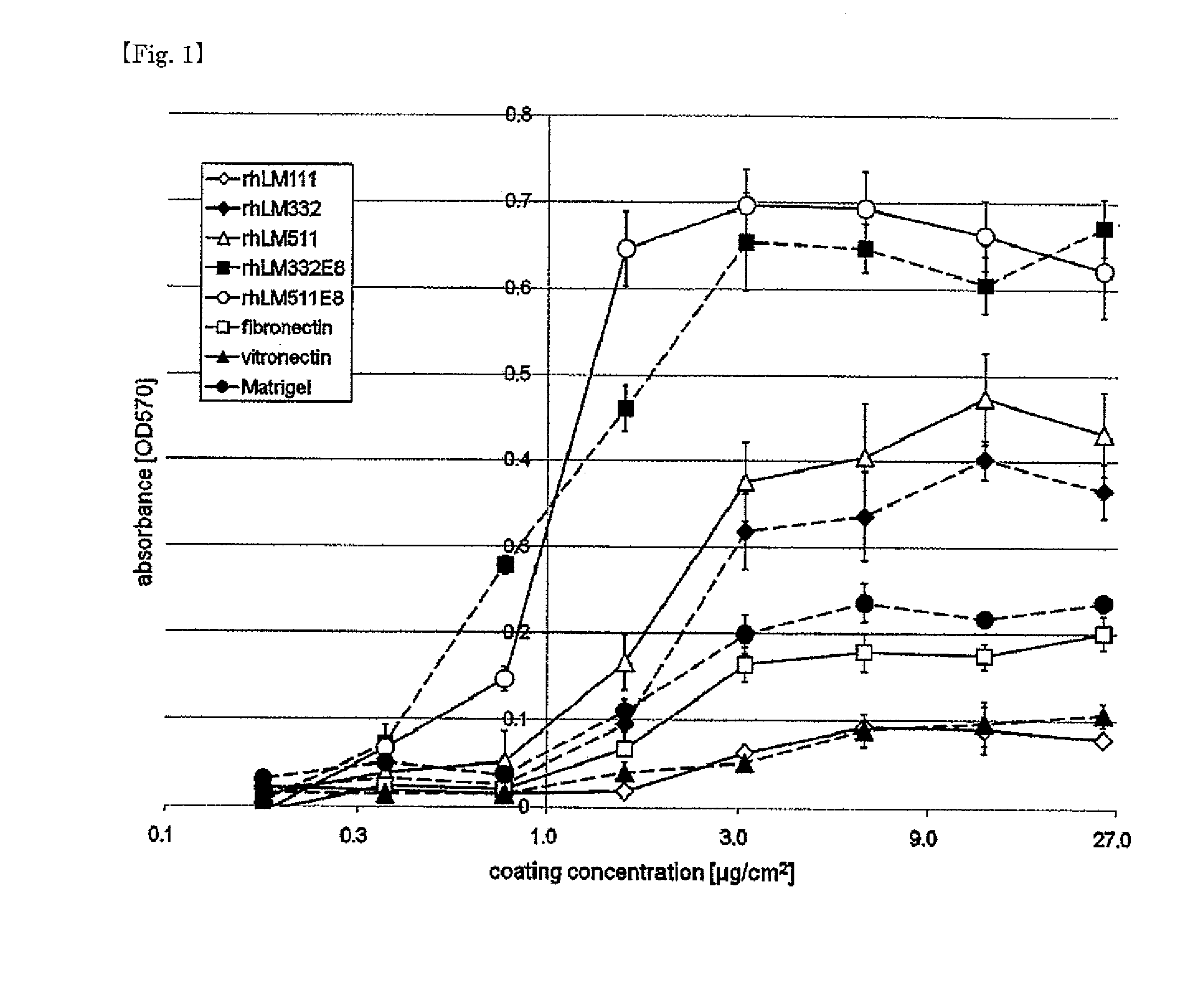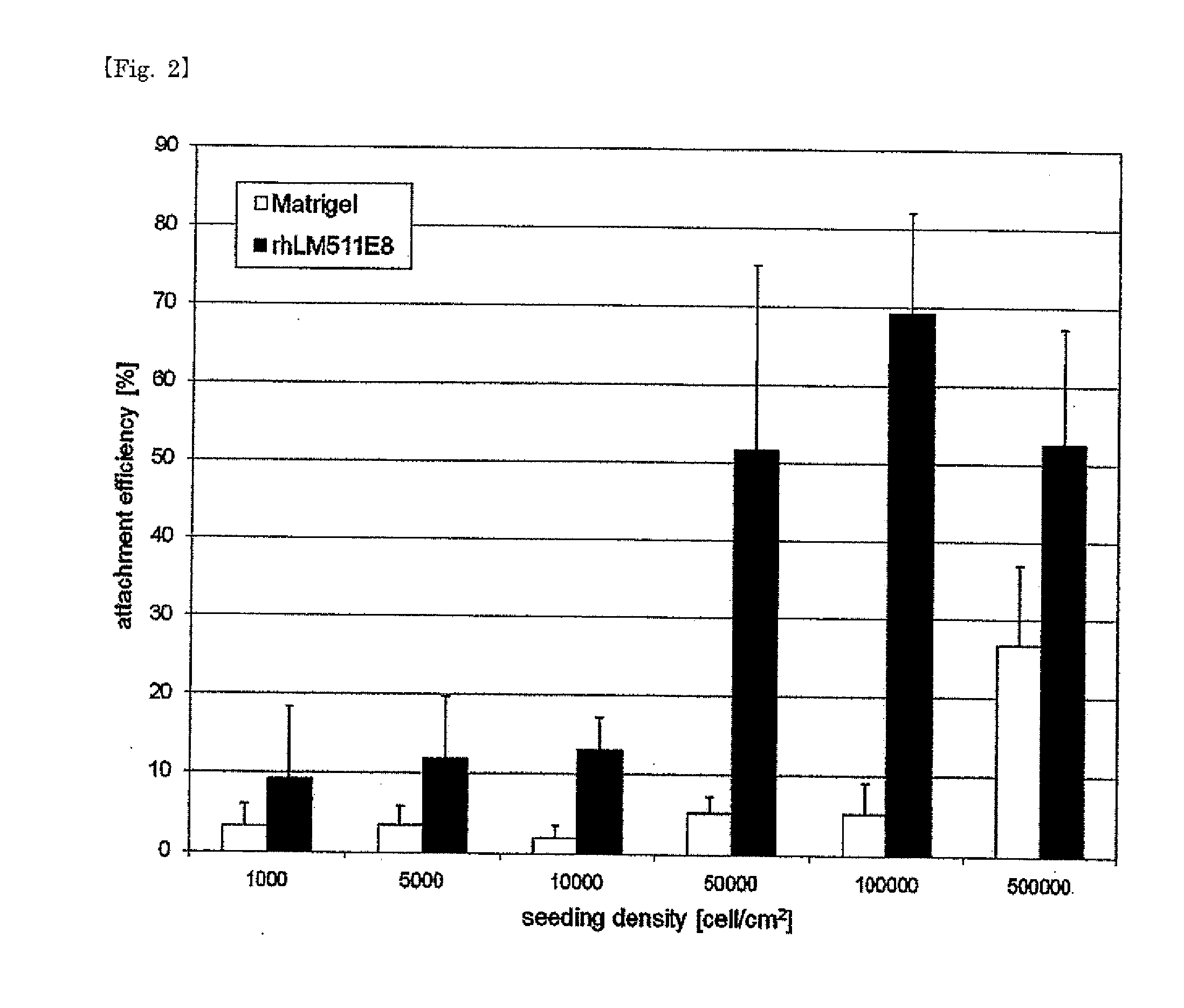Culture substrate for human pluripotent stem cells and use thereof
a technology culture substrates, which is applied in the field of human pluripotent stem cell culture substrates, can solve the problems of inferior maintenance of undifferentiated, inconvenient use of feeder cells, and great restriction on clinical application etc., and achieves high yield, rapid expansion and proliferation, and high safety of human pluripotent stem cells.
- Summary
- Abstract
- Description
- Claims
- Application Information
AI Technical Summary
Benefits of technology
Problems solved by technology
Method used
Image
Examples
example 1
Comparison of Different Extracellular Matrices Based on Coating Concentration-Dependent Attachment Efficiency of Human ES Cells
[0079]rhLM511E8, rhLM332E8, rhLM511, rhLM332, rhLM111, Matrigel, fibronectin and vitronectin were separately diluted with Dulbecco's PBS (Wako Pure Chemical Industries, Ltd. #045-29795) or DMEM-F12 (Sigma #D6241), and then added to separate 96-well microtiter plates (BD Bioscience #351172) at the final concentrations ranging 0 to 25 μg / cm2. The plates were left to stand at room temperature for 2 hours and thus coated with the above extracellular matrices.
[0080]The human ES cells cultured with mTeSR1 (P1) were treated with TrypLE Select (Invitrogen #12563011) at 37° C. for 3 minutes and thereby dissociated into single cells. After the cell number was counted, the cells were seeded at a cell density of 5×104 cells / well on the plates. At 6 hours after seeding, the supernatants were removed, the wells were washed once with DMEM-F12, and the cells were fixed with...
example 2
Effects of Seeding Density on the Attachment Efficiency of Single-Cell Dissociated Human ES Cells on Culture Substrate Coated with rHLM511E8
[0082]In the passage of human ES cells, since dissociating the cells into single cells with trypsin / EDTA etc. causes a marked decline in viability, the cells are usually passaged in the form of a colony. In this example, the attachment efficiency of single-cell dissociated human ES cells onto a rhLM511E8-coated culture substrate was compared with that of single-cell dissociated human ES cells onto a Matrigel-coated culture substrate.
[0083]rhLM511E8 was diluted with Dulbecco's PBS so that the final concentration might be 1.5 μg / cm2. Matrigel was diluted with DMEM-F12 so that the final concentration might be 25 μg / cm2. The two diluted solutions were added to separate 48-well multiwell plates (BD Bioscience #351178), and the plates were left to stand at room temperature for 2 hours and thus coated with rhLM511E8 or Matrigel.
[0084]The human ES cells...
example 3
Morphological Observation and Surface Antigen Analysis of Human ES Cells on Culture Substrate Coated with rhLM511E8 or rhLM332E8
[0086]rhLM511E8 and rhLM332E8 were separately diluted with Dulbecco's PBS so that the final concentration might be 1.5 μg / cm2. Matrigel was diluted with DMEM-F12 so that the final concentration might be 25 μg / cm2. The three diluted solutions were added to separate 35-mm Easy-Grip Cell Culture Dishes (BD Falcon #353001), and the dishes were left to stand at room temperature for 2 hours and thus coated with rhLM511E8, rhLM332E8 or Matrigel.
[0087]The human ES cells cultured with mTeSR1 (P1) were treated with TrypLE Select at 37° C. for 3 minutes and thereby dissociated into single cells. The cells were seeded at a cell density of 5×104 cells / cm2 on the 35-mm Easy-Grip Cell Culture Dishes coated with rhLM511E8, rhLM332E8 or Matrigel. After seeding, the cells were photographically recorded on a daily basis.
[0088]For surface antigen analysis, at 5 days after seed...
PUM
| Property | Measurement | Unit |
|---|---|---|
| molecular weight | aaaaa | aaaaa |
| molecular weight | aaaaa | aaaaa |
| temperature | aaaaa | aaaaa |
Abstract
Description
Claims
Application Information
 Login to View More
Login to View More - R&D
- Intellectual Property
- Life Sciences
- Materials
- Tech Scout
- Unparalleled Data Quality
- Higher Quality Content
- 60% Fewer Hallucinations
Browse by: Latest US Patents, China's latest patents, Technical Efficacy Thesaurus, Application Domain, Technology Topic, Popular Technical Reports.
© 2025 PatSnap. All rights reserved.Legal|Privacy policy|Modern Slavery Act Transparency Statement|Sitemap|About US| Contact US: help@patsnap.com



